Samsung Galaxy S 5 Review
by Anand Lal Shimpi & Joshua Ho on April 8, 2014 12:00 AM EST- Posted in
- Smartphones
- Samsung
- Mobile
- Galaxy S 5
CPU Performance
The Galaxy S 5 marks the second Snapdragon 801 based device we've reviewed at AnandTech, the first being HTC's M8. I've gone through the Snapdragon 801 in depth already, but we're basically dealing with a reasonable upgrade to Snapdragon 800 on an improved 28nm HPm process. The bulk of the improvements impact GPU and ISP performance, but the SoC is just better overall. GS5 owners are lucky as all versions of the device that use Qualcomm silicon feature the MSM8974AC v3 SKU, which includes four 2.5GHz Krait 400 cores and a 578MHz Adreno 330 GPU.
| Snapdragon 800/801 Breakdown | ||||||||||
| SoC Version | Model | Max CPU Frequency | Max GPU Frequency | ISP | eMMC | DSDA | Memory IF | |||
| MSM8974VV | v2 | S800 | 2.2GHz | 450MHz | 320MHz | 4.5 | N | 800MHz | ||
| MSM8974AA | v2 | S800 | 2.3GHz | 450MHz | 320MHz | 4.5 | N | 800MHz | ||
| MSM8974AB | v2 | S800 | 2.3GHz | 550MHz | 320MHz | 4.5 | N | 933MHz | ||
| MSM8974AA | v3 | S801 | 2.3GHz | 450MHz | 320MHz | 5.0 | Y | 800MHz | ||
| MSM8974AB | v3 | S801 | 2.3GHz | 578MHz | 465MHz | 5.0 | Y | 933MHz | ||
| MSM8974AC | v3 | S801 | 2.5GHz | 578MHz | 465MHz | 5.0 | Y | 933MHz | ||
Although Samsung was the first major OEM to be caught cheating in Android benchmarks, it appears to have completely abandoned the practice with the Galaxy S 5's shipping software. Not only was I unable to find any evidence of the old cheats, I couldn't find any evidence of HTC's new subtle cheating either. The Galaxy S 5 appears to be clean as far as I can tell. Kudos to Samsung on doing the right thing, and I hope all other OEMs take this as a sign to stop the silliness.
For our performance tests I turned to our usual suite of browser and native applications. If there's one obvious takeaway from our CPU tests it's that despite having faster silicon than HTC's M8, the GS5 isn't always faster. I believe this has more to do with thermals than anything else. HTC's metal chassis is able to do a better job of dissipating heat than the GS5's plastic chassis. I don't believe there's a substantial impact on user experience, but it's interesting to note how choice in materials can have a performance impact like this.
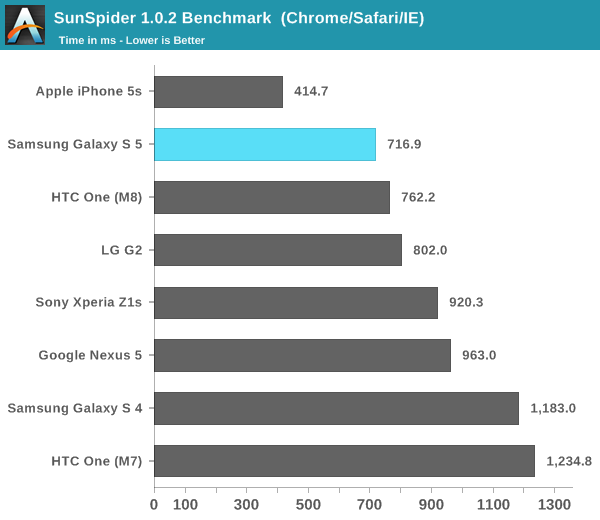
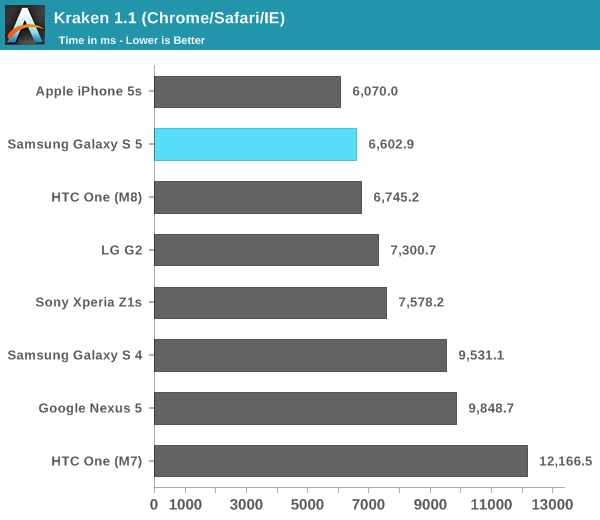
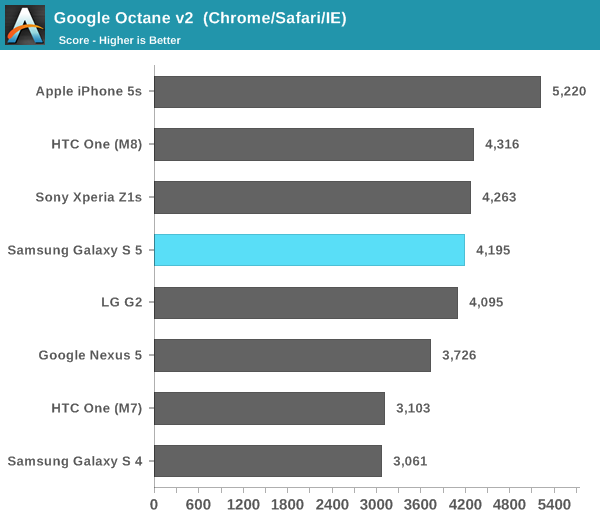
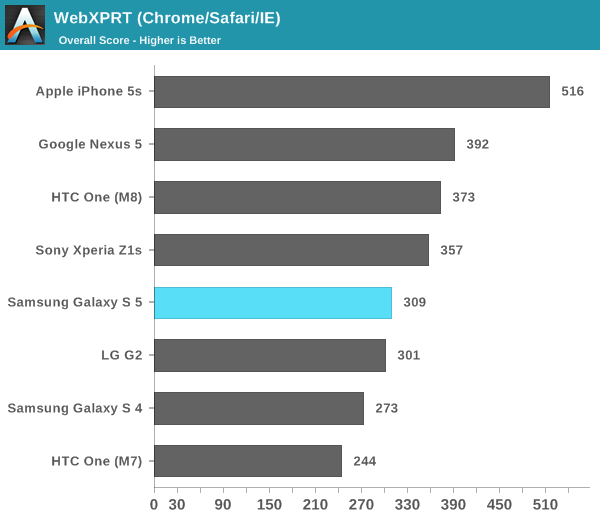
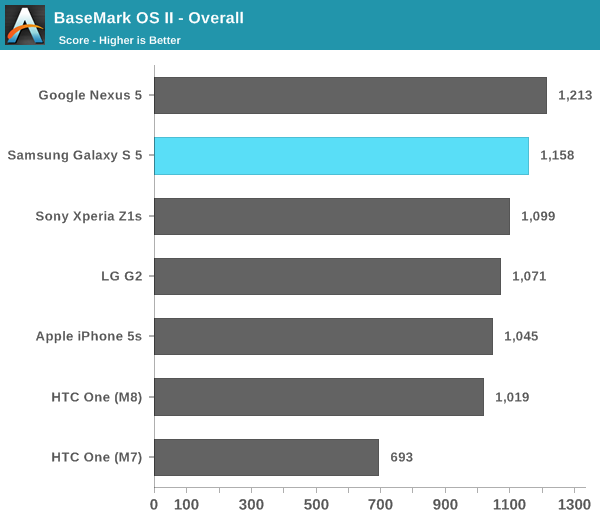
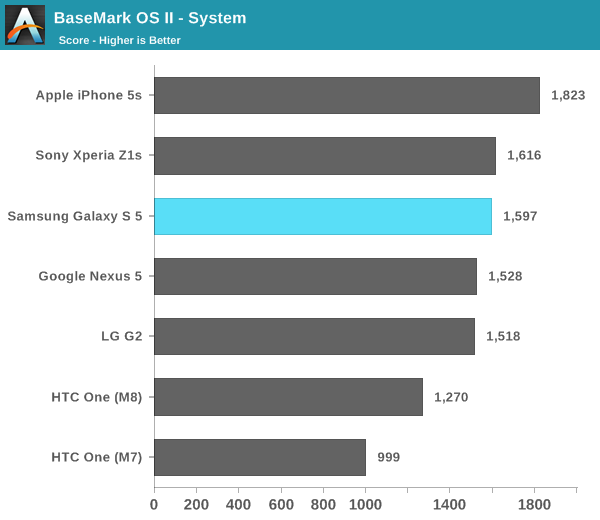
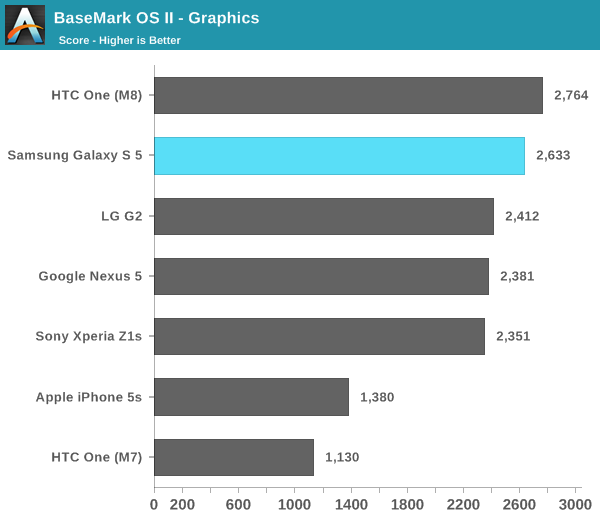

GPU Performance
GPU performance remains where we see the biggest benefit from Snapdragon 801 vs. 800, and since the GPU gains are almost entirely due to frequency scaling it's not too surprising that the M8 pulls ahead of the GS5 here in most cases.
There aren't any surprises here. The Adreno 330 in the Galaxy S 5 is more than capable of driving the device's 1080p display both in current and near term future 3D games.
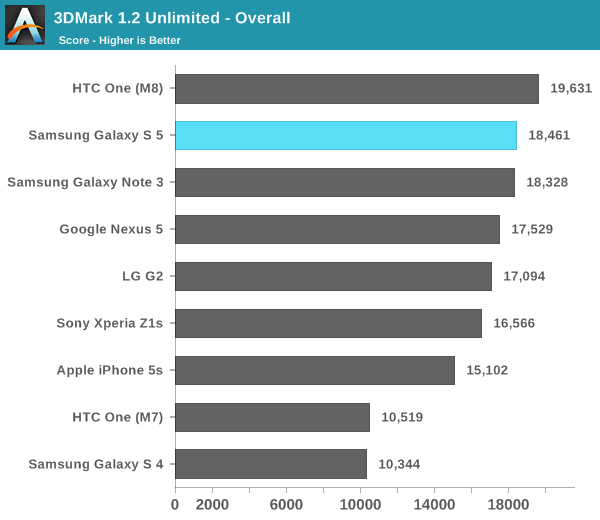
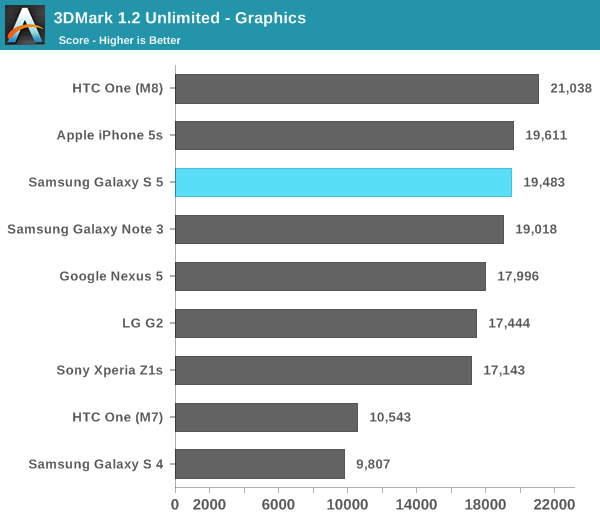
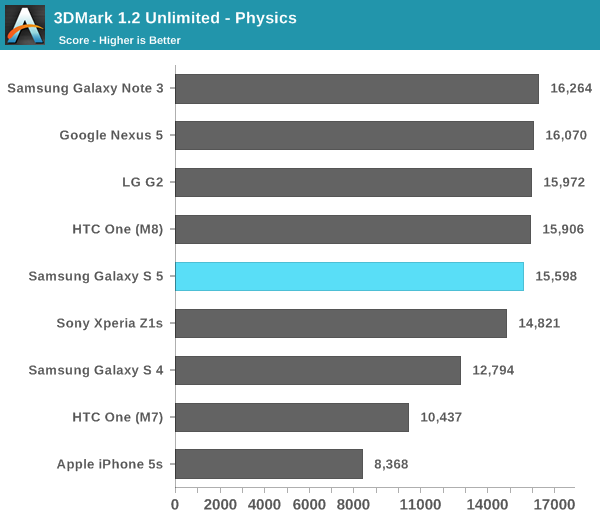
BaseMark X 1.1
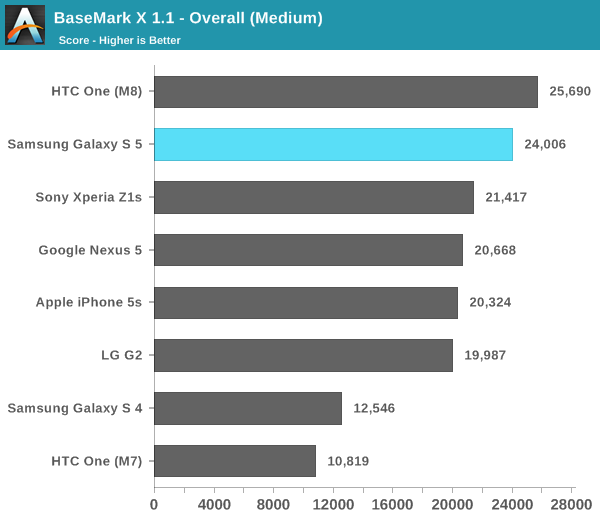

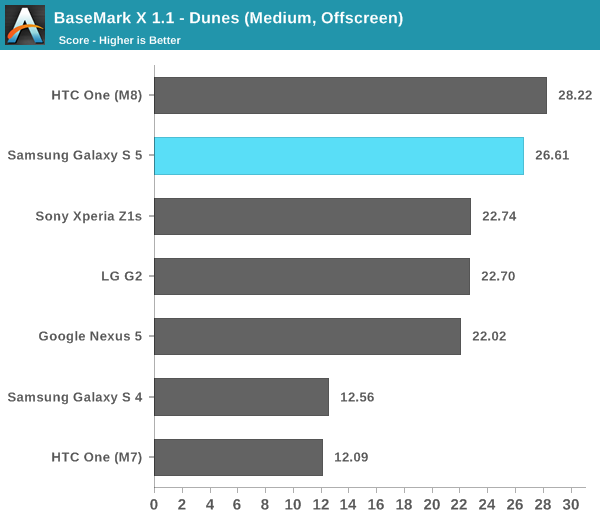
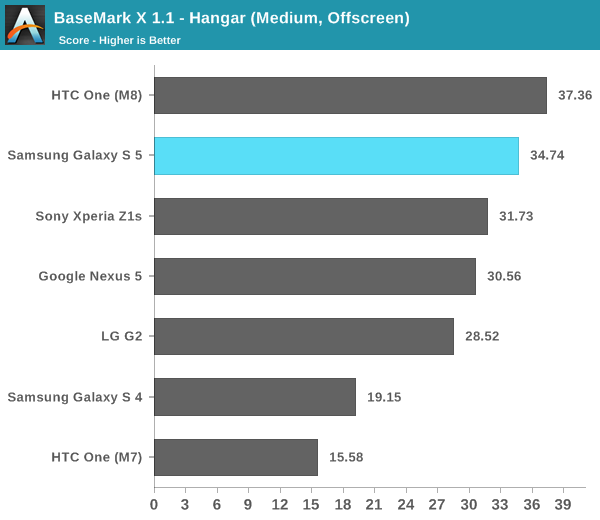

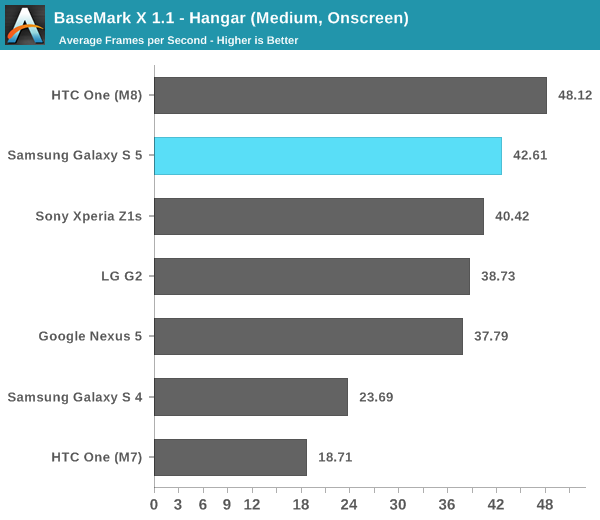
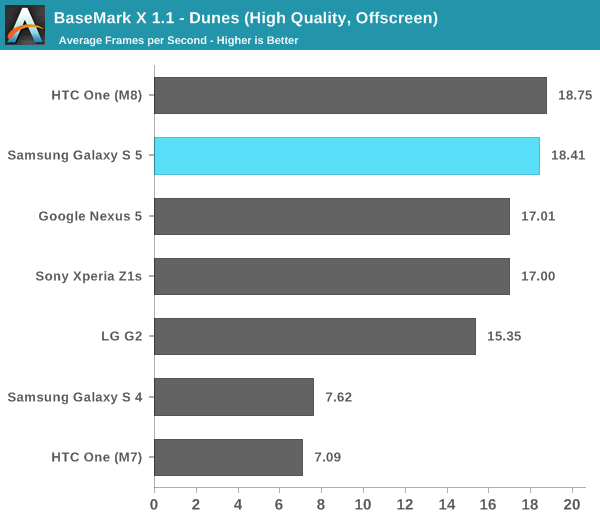
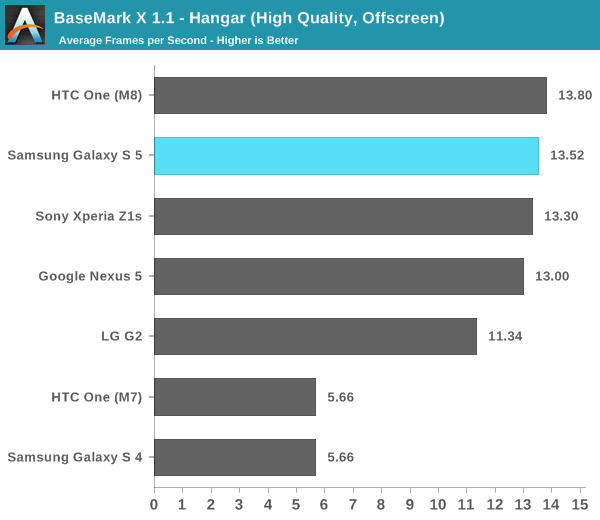
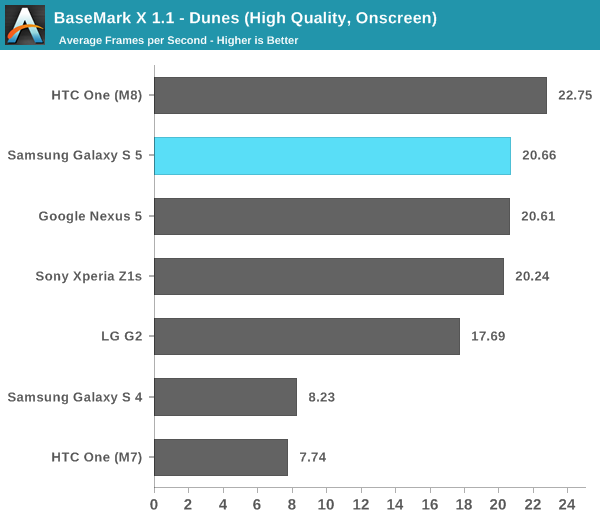
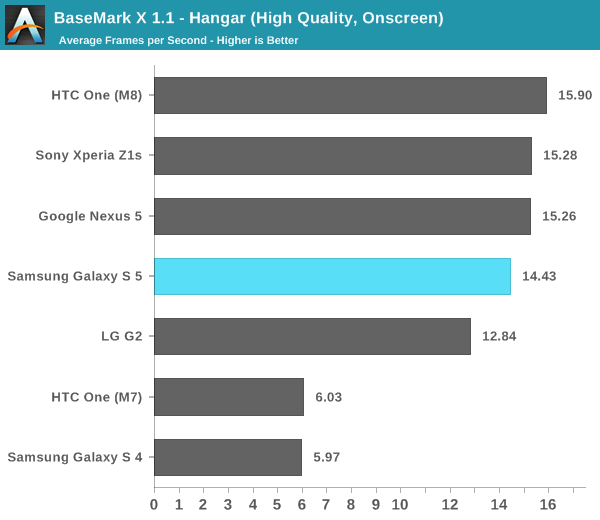
GFXBench 3.0
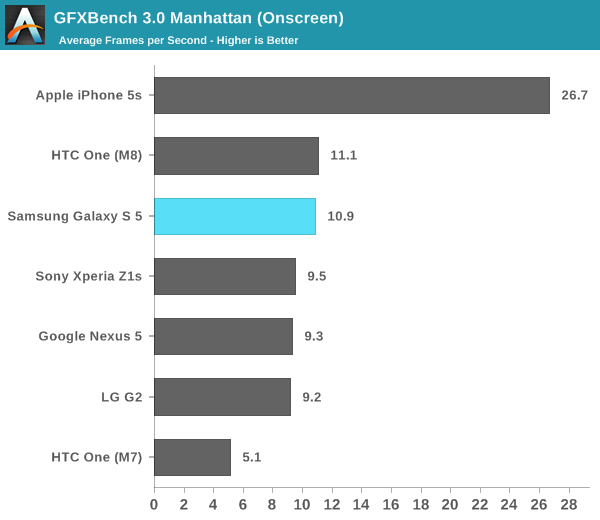
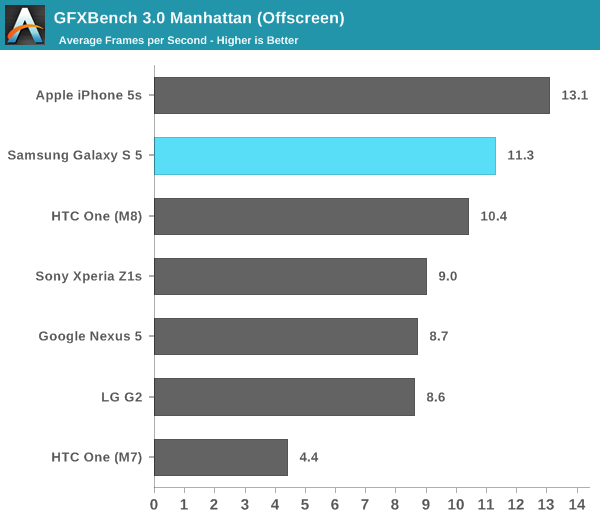
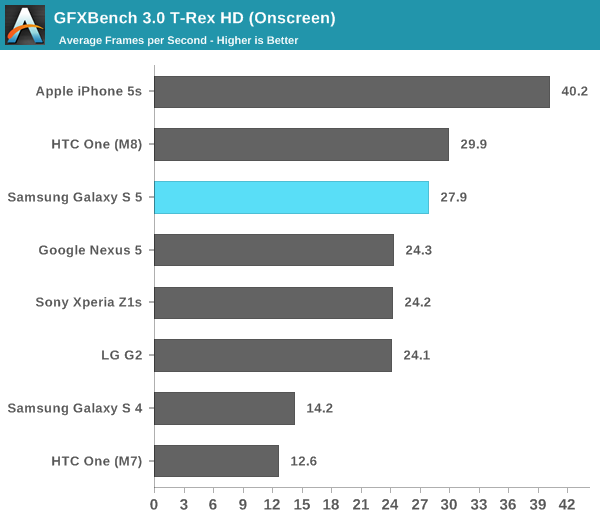
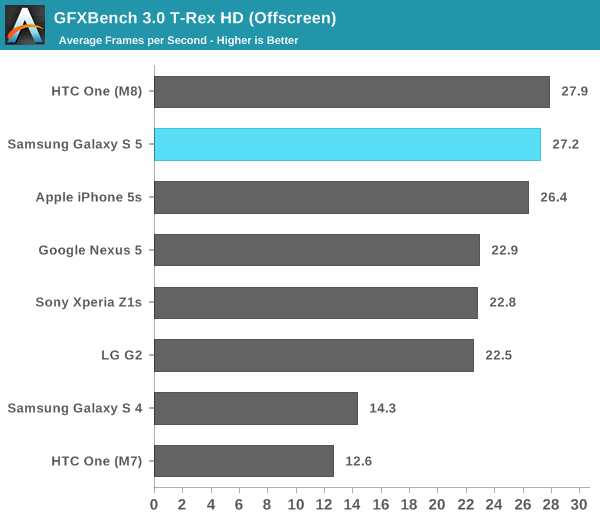

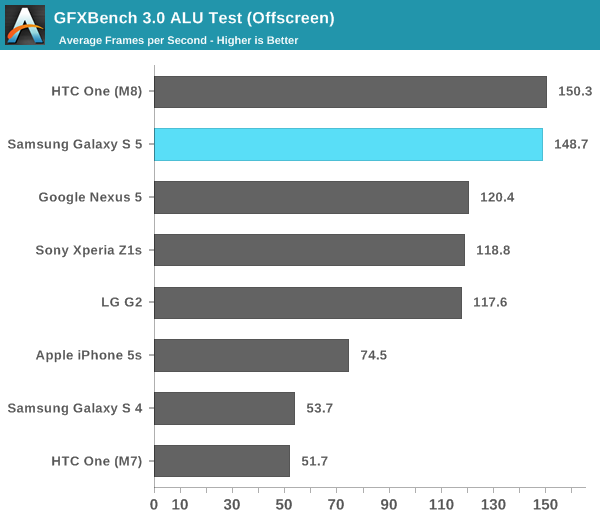


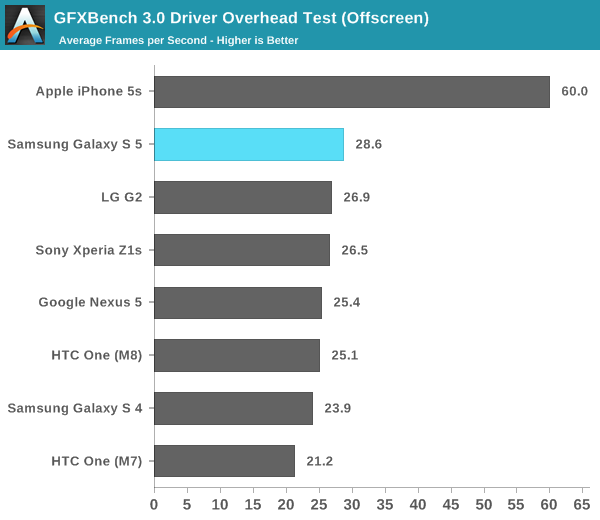
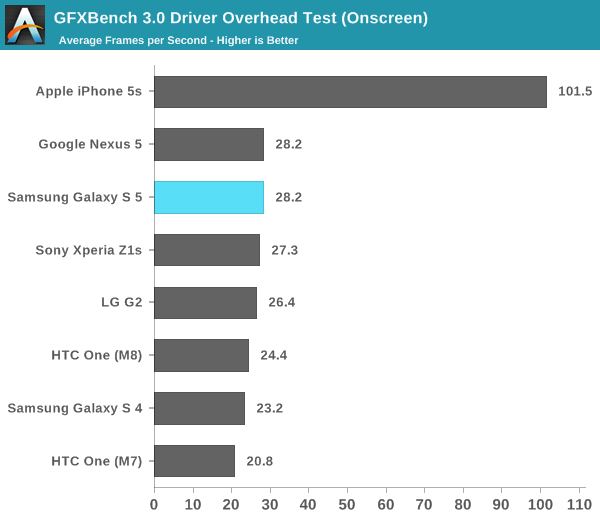
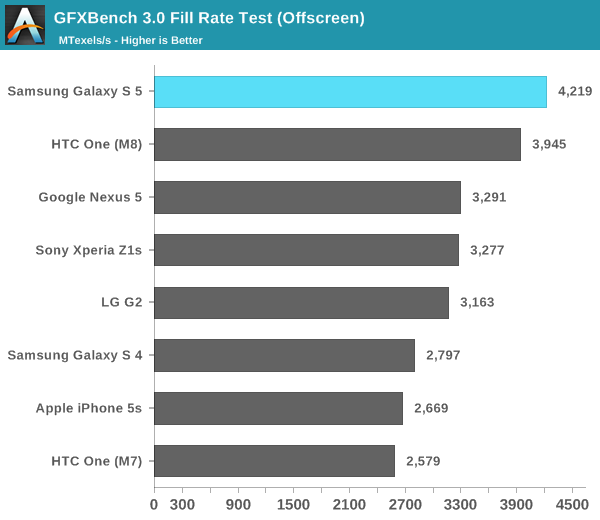
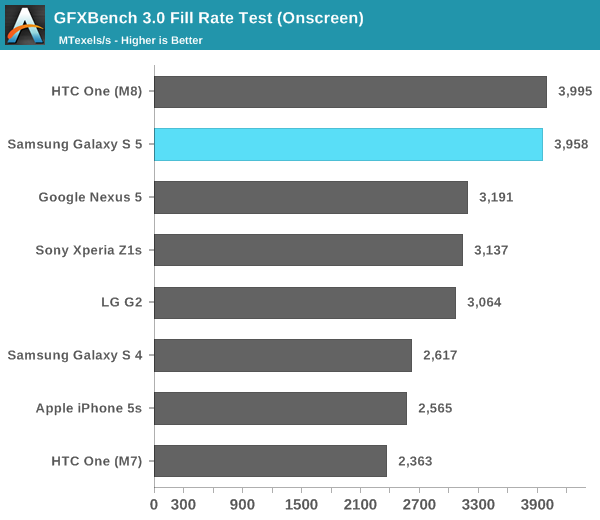
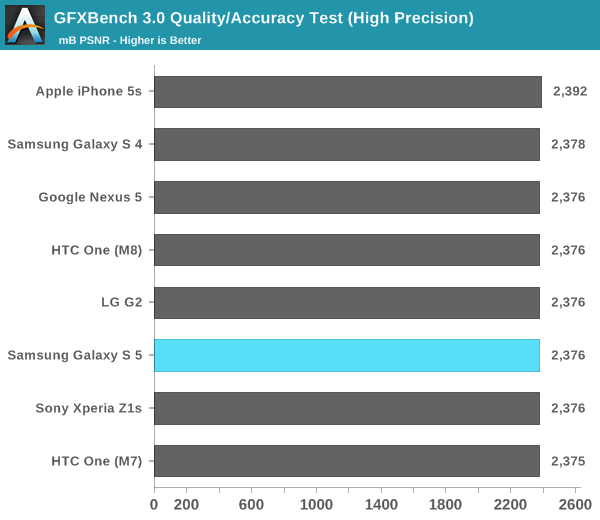
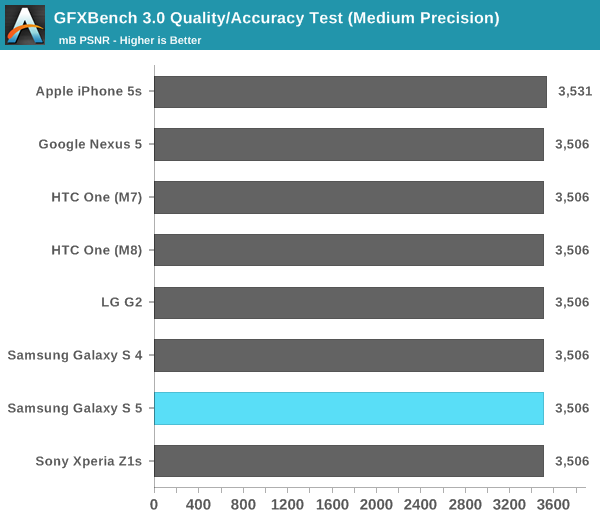
NAND Performance
The GS5 ships with 16GB or 32GB of NAND internally on an integrated eMMC device. Expansion is supported through a microSD card slot behind the removable back cover. Although the Snapdragon 801 inside supports eMMC 5.0, that alone doesn't guarantee a substantial increase in NAND performance. Keep in mind that most OEMs find multiple sources for their internal eMMC/NAND solutions, so what I'm testing here may only be representative of a portion of all GS5 devices.
Samsung sampled a 16GB GS5 review device. I put it through our usual random/sequential IO tests on a 100MB span of LBAs.
Random read performance is disappointing, it falls behind all modern devices we've tested. Random write performance is middle-of-the-road at best. It's unclear to me if this is a cost optimization or a lack of concern for NAND performance, but either way I'd rather see these metrics improve rather than regress.
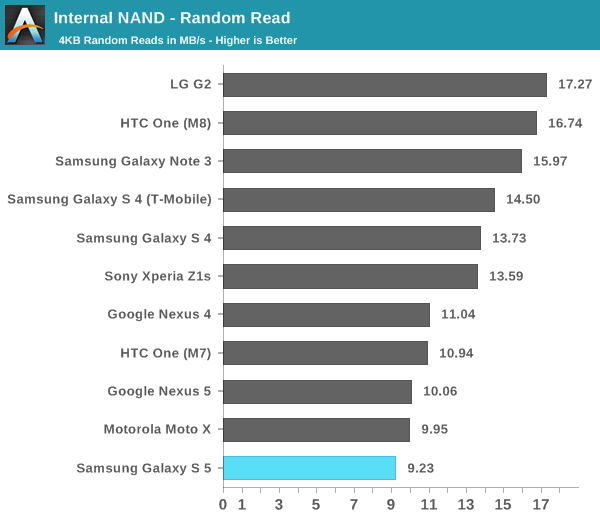
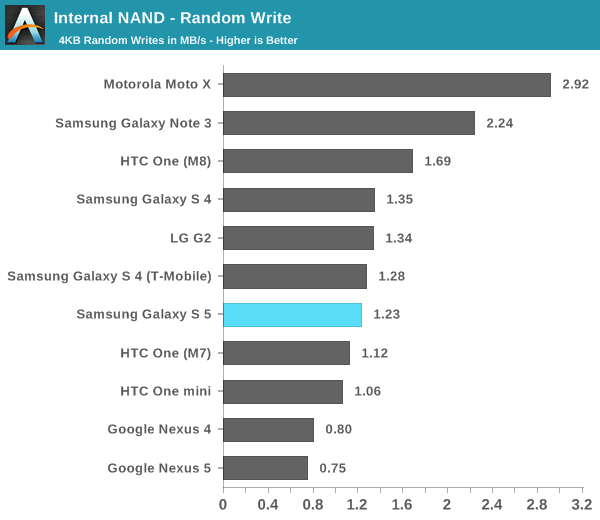
Sequential read/write performance both improve handsomely compared to the Galaxy S 4. I can see why Samsung would want to optimize for these two cases as they are quite common in regular usage, but random read/write performance can also significantly impact user experience.
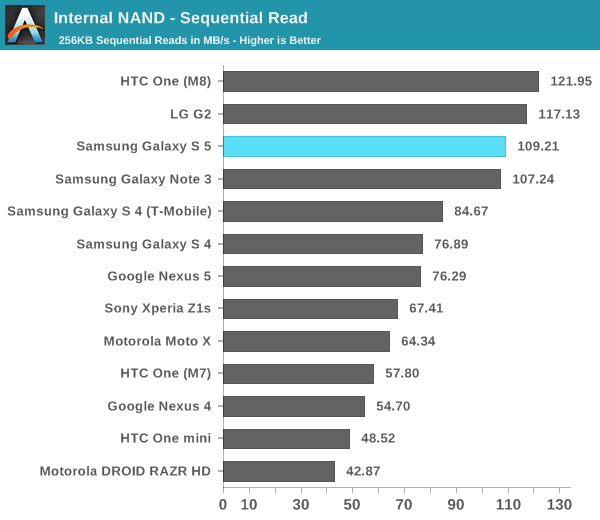
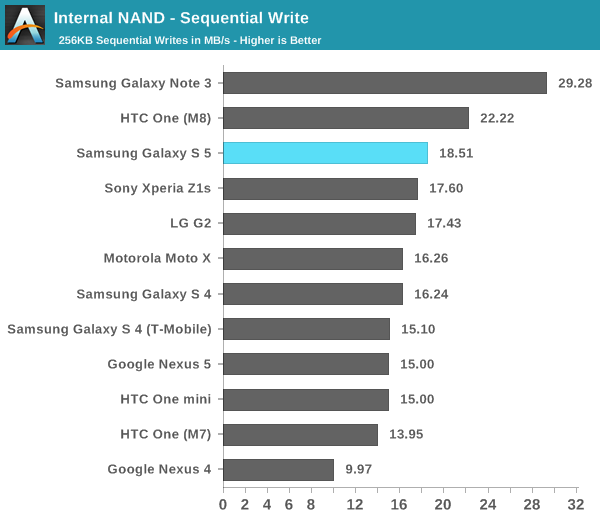










296 Comments
View All Comments
devione - Wednesday, April 9, 2014 - link
LG G2 = 143gGalaxy S5 = 145g
Xperia Z1 = 170g
HTC One M8 = 160g
Apple iPhone 5S = 112g
Sony Xperia Z1C = 137g
One Mini = 122g
Galaxy S4 Mini = 107g
I think the Z1C stacks up pretty well, considering it punches well above its weight compared to the competiton.
doobydoo - Friday, April 11, 2014 - link
It doesn't, though. It's heavier and slower than a 5S. Larger, too.darkich - Tuesday, April 8, 2014 - link
Superior review, Anand!I'd really like to hear what Raymond Soneira would have to say about your display measurements
dishayu - Tuesday, April 8, 2014 - link
"I find that pretty much all the flagships offer some set of tradeoffs that prevent any one from being the perfect device (iPhone's screen size, GS5's materials, M8's camera). It's unfortunate because I'd really like to crown a single device the king of them all, but instead we're faced with a handful of differing optimization points."Try Xperia Z2. I don't really see any significant negative points with that device.
tipoo - Tuesday, April 8, 2014 - link
Is there a way for you guys to test the display touch latency, as shown here? I'm interested in this, the M8 and the Note 3 before it finally made Android phones faster than the iPhones touch latencyhttp://forum.xda-developers.com/showthread.php?t=2...
AnnonymousCoward - Sunday, April 13, 2014 - link
Yes, I agreeHangFire - Tuesday, April 8, 2014 - link
I'm glad to see more testing of the cameras and screens, it is too bad the M7 wasn't represented in the screen shots, as it is a very high density screen. I realize you can't test everything and a last-gen phone is not high on the priority list. On that note there is no excuse for no including a Nokia in the camera tests. My better half's 1520 cam makes this M7 user cry, it is that awesome, and that's not even Nokia's best.ΔrNTA - Tuesday, April 8, 2014 - link
Am I wrong in saying untill Qualcomm start making the SnapDragon 805, all phones exept the obvious one are already out of date until next year?kyuu - Tuesday, April 8, 2014 - link
Yes, you're wrong. The 64-bit thing is totally overblown. It's not going to make any practical difference until we get to a point where 4GB of RAM is a limiting factor in mobile devices. Which won't be for a long time.kyuu - Tuesday, April 8, 2014 - link
Oh wait, you said 805 not 808, my bad. 805 looks to be a largely incremental update, asides from the GPU. So yeah, in a sense I guess you're right. I don't think the difference is anything to be so concerned about that you'd delay a purchase for a half year or so over it, though.